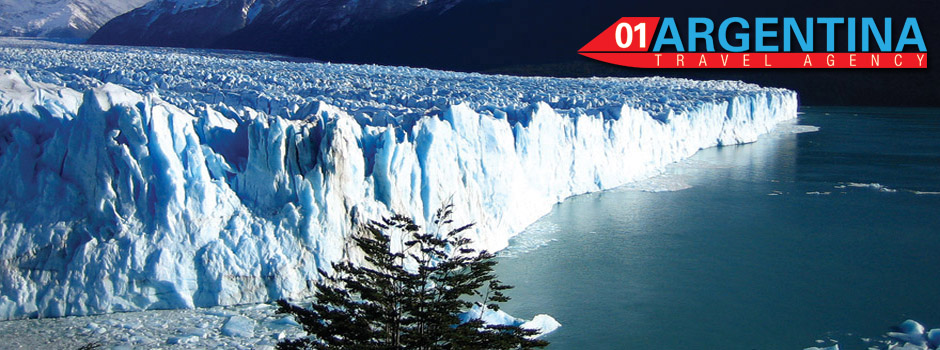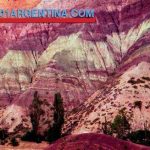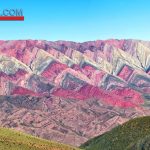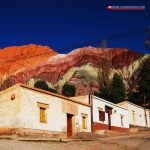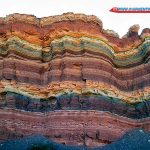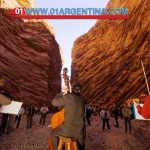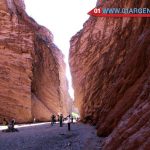Quebrada de Humahuaca y Las Conchas
The Quebrada de Humahuaca is located in the Province of Jujuy and it was declared as World Heritage Site by the United Nations Educational, Scientific and Cultural Organization (UNESCO).
It starts 39 kilometers from San Salvador de Jujuy, the National Route No. 9, and covers about 170 kilometers of valleys and mountains running from south to north. (See map below)
The mountains have different colors according to the minerals that form.
That landscape is between 2,000 and 4,000 meters above sea level and has a strip of 13 kilometers wide watered in times of thaw, the Rio Grande, fresh and plentiful.
Volcano is the first village of the Quebrada, from San Salvador de Jujuy. Later is Tumbaya, at 2094 meters high, with its eighteenth century chapel and a spring where, according to legend, drank San Francisco Solano.
The craft fair of Purmamarca, the national history museum built in 1772 in Posta de Hornillos and carnivals Maimará are other attractions of this place.
In Tilcara Aboriginal tradition is revived, with the presence of the strength of Viltipoco, last chief of the tribe of the Omaguacas, who offered stubborn resistance to Spanish colonization.
In Huacalera, a monolith indicates the crossing of the Tropic of Capricorn and then appears before the eyes of the traveler the people of Humahuaca, with its adobe houses, narrow cobbled streets and the church with his paintings school Cuzco, Peru.
Among its cultural attractions is the Pucara of Tilcara, a fortification that Aboriginal built on top of a mountain, where the valley and access roads dominates.
Humahuaca,World Heritage.
During the meeting held on July 2 in Paris, France, the Andean valley that stretches for 155 kilometers in northwestern Argentina, he won the unanimous vote of the 21 members of the World Heritage Committee of UNESCO, who described the landscape as a “patrimonial system of exceptional characteristics.”
The presentation to UNESCO of all documents that substantiate the nomination of the Quebrada, was sent in late January 2002 and was developed under an agreement between the Federal Council of Investments (CFI) and the Province of Jujuy, signed in June 2001 by the governor of the Province of Jujuy,
Dr. Eduardo Fellner and Secretary General of the CFI, Ing. Juan Jose Ciacera, in the city of San Salvador de Jujuy. Technical studies were prepared through technical and financial assistance from IFC; the agency also assisted in organizing the official annual meeting of the UNESCO mission aspects.
The Quebrada de Humahuaca is a cultural journey of 10,000 years. They walked along its paths indigenous ethnic groups, and that still retain religious beliefs, rituals, festivals, art, music and agricultural techniques that are a living heritage.
With this statement, UNESCO is committed to supporting education and sustainable development of the area and the preservation of the culture of indigenous peoples.
It was included in the category of Cultural Landscape.
This is a new category in which the assets represent a synthesis between nature and cultural tour, since the area of Humahuaca was the unavoidable route between Upper Peru and the Viceroyalty of the Río de la Plata.
The Quebrada de Humahuaca combines a series of natural, cultural and historical attractions, which the province has a large tourist population.
These works are embedded in the Inca Trail, who was born in Ecuador and extended to the south of the province of Mendoza, in Argentina.
That route is one of the sites that UNESCO analyzes include the prized payroll. La Quebrada is a stretch of this great route used by the Incas.
Now, the Argentina together with Ecuador, Colombia, Bolivia, Peru and Chile is preparing a joint submission to UNESCO which, if realized, would be historic, it would mark a policy of cultural integration between different countries in Latin America.
Cafayate Amphitheatre architectural natural acoustics.
La Quebrada de Cafayate or Las Conchas is formed by a series of natural formations caused by water thousands of years ago. Among the most famous is the renowned Devil’s Throat, a deep canyon closed, the final looks like a trachea inviting to rise. It’s like a kind of cavern roof, Taper allows our voices chiming in endless echoes. But as acoustic tourists who we are, what interests us is the natural amphitheater, which opens with a big gap that goes to a gap between rocks, shaped like inverted bottle where there is an excellent acoustics.
This is a semi-enclosed space having walls of more than twenty meters high and completely flat floor. Its shape gives excellent acoustics for music, thanks to having many reflections and widely publicized, having very rough walls.
There is almost always a band playing, and it’s easy to get excited hardness and quality place to wrap us music.
La Quebrada de Cafayate or Las Conchas is formed by a series of natural formations caused by water thousands of years ago. Among the most famous is the renowned Devil’s Throat, a deep canyon closed, the final looks like a trachea inviting to rise. It’s like a kind of cavern roof, Taper allows our voices chiming in endless echoes. But as acoustic tourists who we are, what interests us is the natural amphitheater, which opens with a big gap that goes to a gap between rocks, shaped like inverted bottle where there is an excellent acoustics.
Its great attraction is the rock formations of the Mesozoic and Cenozoic eras, which were sculpted by erosion and many of them have recognizable shapes. Thus, in the course of nearly 40 kilometers, the first figures that emerge are the castles and then, Las Ventanas. El Fraile and then appear at km 34, El Sapo. Ahead lies the Amphitheatre, a natural formation that, by its structure, amplifies the sound.
This is a semi-enclosed space having walls of more than twenty meters high and completely flat floor. Its shape gives excellent acoustics for music, thanks to having many reflections and widely publicized, having very rough walls.
There is almost always a band playing, and it’s easy to get excited hardness and quality place to wrap us music.
The Quebrada de las Conchas was the most visited place by tourists who arrived in Salta in the summer of 2009. Visiting it takes four to six hours, to be delivered the game leisurely contemplating each of the formations, deep into nooks and trails and take pictures in this monumental environment. The reddish color of the rocks is due to the presence of iron oxide, which gives different shades depending on the time of day.
